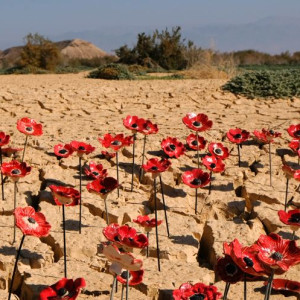Blog
May 5, 2022
A three-month job that’s lasted nearly three decades
The early years of the library
In 1994, a librarian named Tinny Lenthen learned of a short-term job opportunity at the Sydney Jewish Museum’s newly opened library.
“They want someone for just a few months, just long enough to set up the library. Then the volunteers will take over and run it,” she was told.
It didn’t quite work out that way. The Museum soon recognised that having a qualified librarian would be crucial to its success.

Tinny in the library in 2017. SJM Collection.
28 years later, Tinny still sits behind the library desk. She remains one of few constants in a space that has been totally transformed over three decades.
In her time, she has seen the library move twice: from its humble beginnings in the boardroom, to what were once administrative offices and finally, to its home in the Education Resource Centre, which was built in 2015.
“The library collection is such a central part of the Museum’s activities that it is hard to imagine that there was no library when the Museum opened nearly 30 years ago,” she says.
Fortunately, the Museum decided to remedy this. Encouraged by the Museum’s founder, John Saunders AO, members – notably Alex Weinberger, Morris Shell and Stan Grossman – set about raising money to gather relevant books, personal testimonies and other items from members.
This material would be housed in bookshelves, lining the walls of the Museum’s original boardroom and would be officially opened by former Prime Minister Bob Hawke AC in April 1995.

The library was officially opened by Bob Hawke AC GCL, 1995.
The evolution of the library
Today, the Museum library looks very different.
“It’s a Resource Centre, with a collection of more than 8,000 items, including books, journals, audio-visual material, newspaper articles and education kits,” says Tinny.
In 2006, the entire collection became accessible via the Museum’s website, where it became available to users across the world who might otherwise not have known about it.
“The collection offers access to The USC Shoah Foundation’s massive repository of survivor testimonies, the Caplan-Kwiet collection of interviews with local Holocaust survivors recorded in the 1980s, and the oral histories gathered for the Museum’s Community Stories program.”
Over the decades, the library has become an increasingly important resource for students, from primary school children to post-doctoral researchers.
The future of the library
The collection is now focused on extending its outlook beyond the Holocaust to cover other genocides, including the Cambodian, Armenian and Rwandan, in support of our Holocaust and Human Rights exhibition.Tinny says:
“While I don’t see the role of the library changing dramatically in the next 30 years, I envision that sophisticated new technologies will improve our access to materials and help to further expand our collection.”






What’s On Newsletter
Keep up to date on all Museum events and exhibitions.